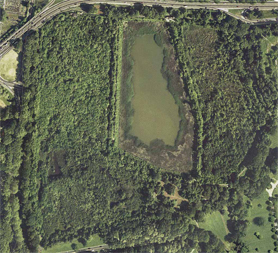The following abstract comes from Round Mountain Ecological’s survey of the Ridgewood Reservoir, which was commissioned by Mark K. Morrison Associates Landscape Architecture. Morrison was contracted by the NYC Parks Department for the reservoir project.
“We conducted a survey of the flora and fauna of the Ridgewood Reservoir site in Queens, NY, in the summer and fall of 2007. No less than ten plant and animal species listed as Threatened, Endangered or Special Concern in New York State were found at the site. A total of 173 plant species were observed, three of which are listed as Threatened or Endangered in New York State. Several plant communities observed were also of significant conservation concern. The bog-like open areas and forest fringes in the East Basin, where thick carpets of mosses dominated the understory, for example, appeared to be entirely unique within New York City and should clearly be preserved. Also of conservation concern were the significant areas of wetland and ecotonal habitats present at the site, including not only the emergent marshes and open water of the Central Basin, but the entire East Basin and southern half of the West Basin as well.
A total of 127 bird species were observed during fall migration at the site, including seven species which are listed as Threatened or Special Concern in New York State. A breeding bird survey conducted by local naturalists in 2007 also confirmed or suspected 38 bird species to be nesting at the site. The high diversity and abundance of bird and other wildlife species present at the site appeared to be due the abundance of food resources present, the diversity, size and contiguity of habitats at the site, and its location on the ridge of the Harbor Hill glacial moraine, which puts it directly in the flight path of a large number of species migrating through the area. The significance of the site for bird species is well-known, both presently and historically, it being listed among the top 500 places to see birds in all of New York State as far back as the 1970’s.
Further studies are needed to determine the significance of the site for wintering and migratory birds, breeding rails, spring flora and aquatic plant species. However, based on the data from the summer and fall of this year, it is clear that one of the major priorities for maintaining and enhancing the biological integrity of the site is confronting the rampant growth of exotic, invasive plant species present there. More than 20 such species were documented at Ridgewood Reservoir in 2007. One or more of these species were dominant in 85% of the plant communities described by Parks' Natural Resources Group (2006).
These species should be actively replaced with native species that have comparable or greater ecosystem, wildlife and aesthetic values, using seed collected onsite or from nearby natural areas. This would not only serve to inhibit the future growth of invasive species, but would enhance the native species diversity at the site, which appears to be somewhat diminished by its severe isolation from other existing natural areas.
Accomplishing all these goals will require significant, long-term devotion of financial and other resources. However, the costs could be greatly reduced by building on the strong community of residents, naturalists and others who already regularly visit the site. Activities such as exotic plant removal, native species planting and propagation, and biological monitoring offer excellent opportunities for environmental education, research and community involvement. The development of such programs and activities would be further facilitated by establishing a small nature center at the site. By combining the resources of the park system and local community to bring about the
conservation and restoration of the site, Ridgewood Reservoir could effectively become a model of environmental stewardship for other parks in New York City, and the world, well into the future.”
This report clearly states that preservation of nature at this site must be paramount. One of the threatened bird species observed at Ridgewood Reservoir is the Short-eared owl. The discovery of this same species at a development site in Calverton, Long Island caused the New York State Department of Environmental Conservation to step in and shut down all construction activity there in February 2008. The DEC is in possession of the Round Mountain Ecological survey and is reviewing it. The Parks Department must obtain the state agency’s approval before any major alterations can be undertaken at Ridgewood Reservoir.




